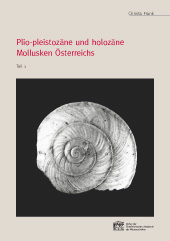
Plio-pleistozäne und holozäne Mollusken Österreichs, pp. 797-807, 2006/11/10

Die Ergebnisse der quartärmalakologischen Forschung finden in Österreich zunehmend Beachtung: Sie ergänzen nicht nur paläontologische, paläobotanische, sedimentologische, ur- und frühgeschichtliche Befunde durch die Möglichkeit, ehemalige Lebensräume, Klima- und Vegetationsverhältnisse zu rekonstruieren, sondern lassen auch anthropogene Einflussnahmen auf die Landschaftsentwicklung erkennen. Voraussetzung für das Verständnis pleistozäner und holozäner Artengemeinschaften ist eine möglichst gute Kenntnis der rezenten Gegebenheiten. Dieses Buch basiert auf mehr als 30 Jahren intensiver wissenschaftlicher Arbeit, die Molluskenmaterial aus ca. 170 österreichischen Fundstellen, insgesamt mehr als eine Million Objekte, umfasst. Vordergründige Anregung dafür war das profunde Werk von V. LOŽEK über die Quartärmollusken der Tschechoslowakei (erschienen 1964). Der Text besteht aus einer Übersicht und Kurzcharakteristik der Fundstellen, dem systematischen Hauptteil mit morphologischer Beschreibung jeder Art, Angaben zu den Habitaten, der bekannten zeitlichen und räumlichen Verbreitung sowie dem jeweiligen Fundstellenregister; weiters aus einem Kapitel über die Entwicklung der Molluskenfauna im Holozän, einem Verzeichnis aller rezent aus Österreich gemeldeten Molluskenarten und Literaturangaben. Alle Arten sind abgebildet und ihr Vorkommen anhand von Verbreitungskarten dargestellt.
…
In addition to research in palaeontology, palaeobotany, sedimentology, archaeology and prehistory, the study of Plio-Pleistocene and Holocene mollusca has become more and more important. Mollusca are very helpful in reconstructing past environments, since faunal development corresponds directly to changes in vegetation and climate. Since the Quaternary malacofauna consists mainly of species also represented in present day fauna, knowledge of their modern requirements is a fundamental necessity. In addition, molluscan groupings can give evidence of anthropogenic impact on the environment. Some species have chronostratigraphic importance. This volume provides a complex of information on the Quaternary mollusca of Austria. It is based on the material collected from more than 170 palaeontological and archaeological sites, which have provided altogether more than one million specimens. An initial impulse for this work came from V. LOŽEK’s in-depth study on the Quaternary mollusca of Czechoslovakia (published in 1964). The present volume includes: a register and brief description of the sites; a description of the morphology and biology of all species as well as their appearance in the different localities and layers; zoo-geographical patterns; a comprehensive list of relevant literature; an analysis of the development and features of the malacofauna during the Holocene; an attempt to correlate the finds with malacological data and biozones of other European countries; a catalogue of all the present mollusca of Austria; numerous illustrations and maps.